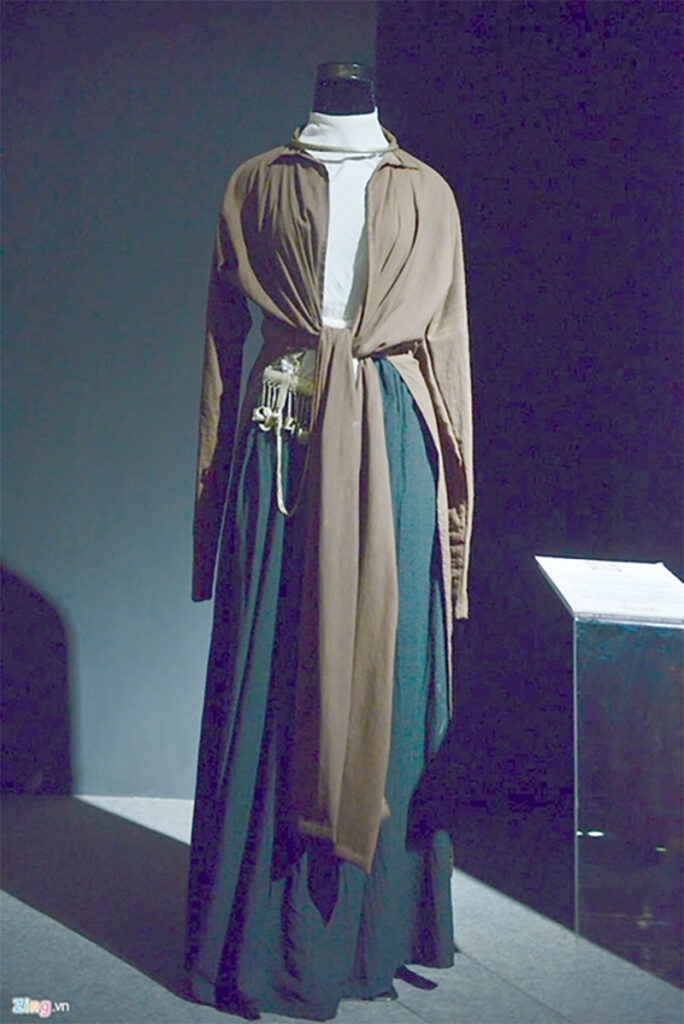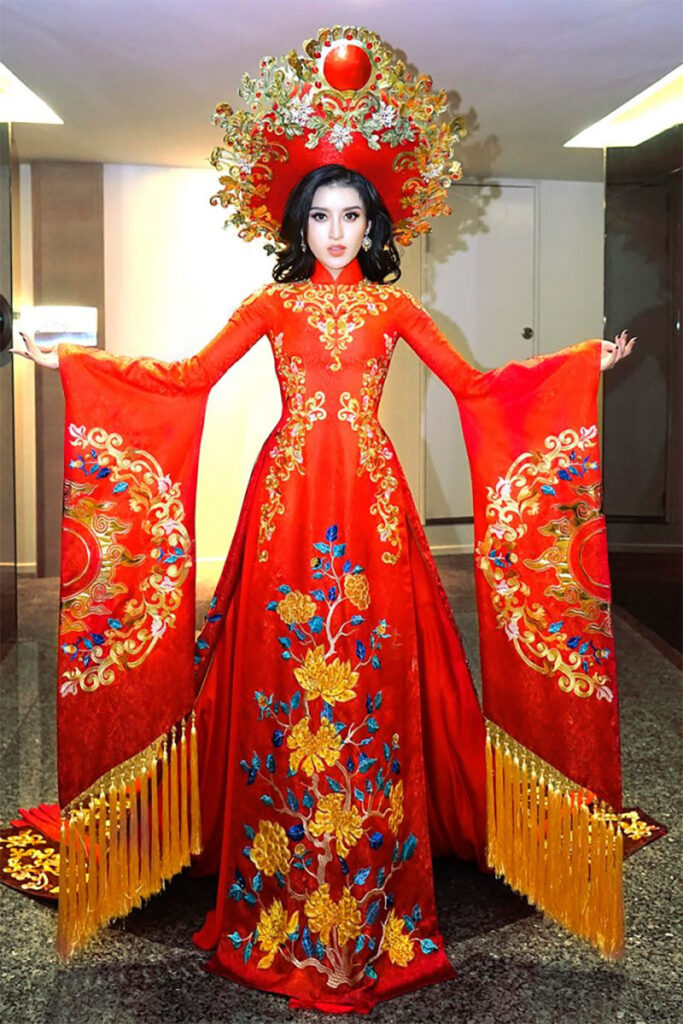
For many generations, the Áo dài (Vietnamese traditional gown) has become a beauty in Vietnamese culture, and it is an indispensable outfit in essential events of the country.
Contents
History of the development of vietnamese traditional gown through the ages
The Áo dài (vietnamese traditional gown) has undergone many development periods, each with its unique characteristics.
Áo dài has long been a traditional costume and a typical cultural feature of the Vietnamese people. Through each period of historical development, Áo dài constantly changes but still ensures respect for the traditional gentle beauty of Vietnamese women.
Áo dài has evolved over many years and has become a feature of the Vietnamese fashion industry and a political and cultural identity since it first appeared during the Nguyen Dynasty.
Áo Giao lĩnh
Researchers have yet to accurately determine the history of Áo dài and the time of its appearance. According to Chinese people’s perception, the Áo dài comes from the cheongsam, but the cheongsam has only appeared since 1920, and the Áo dài appeared thousands of years ago.
The appearance of Áo dài originates from the Giao Lĩnh Áo dài (in 1744) – the most primitive style of vietnamese traditional gown. Áo dài, also known as Áo dài, is sewn loose, slit on both sides, has wide wrists and is heel-length. The shirt’s body is sewn with four fabric panels combined with a colored belt and black skirt. This is a cross-neck shirt similar to a four-piece shirt.

At this time, King Nguyen Phuc Khoat ascended the throne and ruled the southern region. Lord Trinh governs the north in Hanoi, people here wear military uniforms and costumes similar to those of the Han people. King Nguyen Phuc Khoat required all his assistants to wear long pants underneath a silk shirt to distinguish between North and South. This dress combines Han and Champa costumes. This may be the image of the first Áo dài.
Four-piece Áo dài (17th century)

According to researchers and artifacts at Áo dài museums, to make it more convenient for women in productive labor, the Giao Linh Áo dài was sewn separately with two front flaps to tie together and two back flaps sewn together, sewn together into a hem.
This type of shirt is usually made in dark colors and is considered a rustic and modest shirt that symbolizes the four parents of the couple.
Five-armed Áo dài (during the reign of King Gia Long)
Based on the four-body shirt, the five-body shirt appeared during the reign of King Gia Long. This type of shirt is often sewn with a small flap to symbolize the wearer’s status in society. The aristocratic Mandarin class often wore five-colored shirts to distinguish themselves from the working classes in society.
The shirt has four flaps sewn into two flaps like an Áo dài, on the front flap, there is an additional flap as a discreet lining, which is the 5th flap. This type of shirt is sewn in a wide shape, has a collar, and has been very popular since the beginning of the twentieth century.
Lemur Áo dài
This style of Áo dài was modified from the five-piece Áo dài created by artist Cat Tuong in 1939. Lemur Áo dài is named after her French name, and the Áo dài has only two flaps, front and back, the front flap is floor-length. The shirt is sewn close to the body, has straight sleeves, and has tiny hems. The shirt’s buttons were opened to the side to accentuate its femininity. This shirt style was popular until 1943 and then was forgotten.

Le Pho Áo dài
This is also a new combination of the four-body Áo dài, a variation of the Lemur Áo dài by artist Le Pho, so it is called Le Pho Áo dài.
She reduced the size of the Áo dài to fit the Vietnamese woman’s body, pushed up the shoulders, lengthened the hem to touch the ground, and brought in many new colors. In other words, she makes it more sexy, sophisticated, and attractive.
After four years of popularity, artist Le Pho removed all Western influences and replaced them with details from the four-piece Áo dài. From this time until the 1950s, the vietnamese traditional gown style became highly famous in the country’s tradition.

Raglan Áo dài
Raglan Áo dài, also known as Áo dài, appeared in 1960 and was created by Dung tailor in Dakao, Saigon.
The most significant difference of the Raglan Áo dài is that it hugs the body more closely, and how the arms connect from the neck diagonally down to a 45-degree angle helps the wearer feel more comfortable and flexible. A row of buttons on the side connects the two flaps. This type of Áo dài contributes to shaping the style of Vietnamese traditional gowns later.

Vietnamese traditional gown (from 1970 to present)
Vietnamese traditional gowns have changed over time with many designs and materials, from modern to unconventional. Áo dài is also transformed into wedding dresses, innovative dresses… But no matter what, the traditional Áo dài of Vietnamese women still retains the flexibility, sexiness, and discreetness that no other outfit can bring.

Along with the dynamic and changing trends of modern lifestyles, the traditional Áo dài is stylized by designers with shorter hems, changes in the collar, sleeves, or even the shirt or pants worn together. Áo dài gives Vietnamese women many choices.
Because of this stylization, Áo dài is increasingly worn by Vietnamese women daily.
You can see colorful Áo dài with many new and unique designs in offices, sacred temples, or outside.
With such a long development history, the vietnamese traditional gown has become more perfect than ever. Áo dài has become a symbol of culture, enhancing the beauty of Vietnamese women.
It can be said that Áo dài is not only a costume representing an entire culture but also a constant inspiration for Vietnamese art.
The traditional cultural beauty of Vietnamese women is expressed through the Áo dài
Overcoming its value as a consumer product, the Áo dài has achieved a more important role as a unique cultural product imbued with national identity, a symbol of Vietnamese women.
Áo dài not only lives in the hearts of Vietnamese people but is also included in arts such as painting, music, cinema… It is difficult for such a simple dress to live on over time. Hundreds of years and shows no signs of stopping.
The Áo dài is imbued with the philosophy of life
The Áo dài originated from the four-paneled Áo dài, but over the years, it has been improved to what it is today. The image of a vietnamese traditional gown with two flaps symbolizing the four relatives and parents and five flaps buttoned on the left side of the shirt not only keeps the Áo dài neat and discreet but also represents the five core personalities of the people: benevolence, courtesy, righteousness, wisdom, faith. Thus, Áo dài not only carries the traditional beauty of Vietnam but also the philosophy of life.
Although going through many different stages of development in the process of exchange and integration of East-West culture, the reformed Áo dài has changed a lot compared to the original. However, the vietnamese traditional gown still retains its own identity. Today, this outfit has changed, improved, and upgraded in terms of materials, styles, colors, and patterns… to become more sexy, sophisticated, and attractive.
Vietnamese traditional gown honors the beauty of women
If the Japanese are proud of kimonos, Koreans are famous for hanboks, and Vietnamese people are always known for their graceful and graceful Áo dài.
The overall vietnamese traditional gown is a revealing yet discreet outfit, complete with freedom and generosity. However, it still ensures luxury, elegance, elegance, and necessity. Therefore, Áo dài is easily widely popular among all classes of people and can be used in many different spaces, times, and events.

Áo dài – the breath of Vietnamese culture
Through historical and cultural periods, today, the vietnamese traditional gown is still the traditional outfit for solemn occasions of the family, clan, community, or during the country’s holidays. Áo dài is worn more and more by girls in schools, offices, and businesses, including student Áo dài, office Áo dài, and uniform Áo dài. In important events of the country, on international forums, the solemnity and elegance of Vietnamese women are demonstrated.
At the same time, Áo dài contributes to honoring the cultural lifestyle of the Vietnamese people, which is the spirit of solidarity. Áo dài is beautiful and has many meanings today because Vietnamese families attach great importance to the bond of love. Áo dài is a special bond in the family, especially on family reunions.
Áo dài festival
Thanks to its invaluable values, every year, Vietnam organizes many competitions and performances about Áo dài to preserve and promote that special Áo dài to people across the country as well as friends on five continents.
In particular, the annual Áo dài festival receives attention and investment from the government to honor vietnamese traditional gown. Generally, in early March every year, the Áo dài Festival will occur across the country. The festival can last for 1 or 2 months, during which many special events occur.
This is not only an opportunity for Vietnamese people to show off their elegant and sophisticated beauty but also for Áo dài designers to show off their talent and class to many people…
Áo dài is also promoted and honored by many localities across the country in many forms.
During Hue festivals, it is impossible not to mention the Áo dài Festival – one of the official programs imbued with Hue culture, which has contributed to enriching and diversifying the festival program as well as the success of Hue.
Coming to the Áo dài Festival, visitors will admire Áo dài collections of famous designers. There, the Áo dài of Hue women, in particular, and vietnamese traditional gown, in general, are transformed through the talented hands of artists to become collections with ancient to modern looks in wealthy and diverse materials.
Hue Áo dài has become a unique tourist product, creating a charm and mystery that makes anyone who sees it feel moved. The delicately cut, sewn, and embroidered Áo dài by the talented hands of Hue craftsmen have left many good impressions in the hearts of domestic and foreign tourists, contributing to preserving and promoting the nation’s unique and precious cultural features.
Through Áo dài, Hue culture is widely and effectively promoted to domestic and international tourists, at the same time honoring the gentle beauty of the person wearing Hue Áo dài.
In Ho Chi Minh City, after nine times of organization, the 2023 Ho Chi Minh City Áo dài Festival has many companions as image ambassadors. This year, there are 22 image ambassadors: artists, travel bloggers, business people, designers, diplomats, teachers, etc. Especially Annabelle Mae Mcdonnell – 1st runner-up in Miss Charm 2023.
The festival highlights that female consul generals and wives of consul generals of other countries wear Áo dài to respond to the activities, aiming to tighten the friendship between Vietnam and other countries.
In Can Tho, on October 14, the Ba Ba and Áo dài parade with the theme Southern Charm, with the participation of 5,000 women organized by the Can Tho City Women’s Union, was held. Vietnam’s record set a record for the most significant number of participants.
